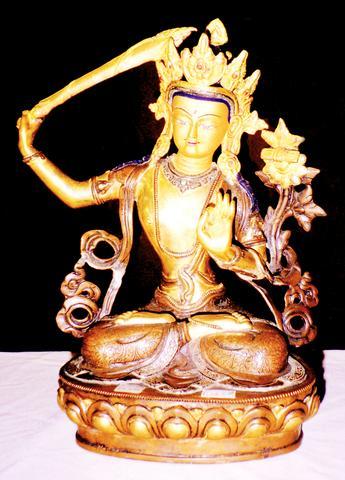A common concern with historical artifact exhibitions is their tendency to cater to academics versed in a particular field, while excluding the general public by not supplying any descriptive text about the collection.
The Mongolian and Tibetan Cultural Artifacts Exhibition L in Taipei attempts to be informative with an extensive selection of relics from Mongolia and Tibet. But, while the labels are in both English and Chinese, viewers are still limited in what they can learn from the experience due to a lack of supplementary information on the pieces.

PHOTO COURTESY OF MONGOLIAN AND TIBETAN CULTURE CENTERN
Sponsored by the Mongolian and Tibetan Affairs Commission in Taipei, the exhibition covers two floors with both historical and modern-day items on loan from a museum in Ulaan Bator. The main level comprises mostly Vajrayana Buddhist iconography, which -- for anyone interested in Tibetan Buddhism -- has an impressive collection of vajras and stupas.
Likewise, there is a large sand mandala with a display of photos taken during its construction by a group of Tibetan Buddhist monks visiting Taiwan. The mandala is striking, but the sense of impermanence -- which is normally revealed when a mandala is destroyed -- is lost when the glue marks are noticed through the dusty glass showcase.
A Mongolian yurt (tent house) has also been set up on the main level and is one of the few items with any accompanying text. Although the inside bares a resemblance to a typical Mongolian tent-home, the missing stove and floor beds diminish its authenticity. Behind the yurt is a somewhat comical and randomly placed collection of stuffed toy animals that does not have any labeling, but is presumably meant to represent Mongolian camels and Tibetan yaks.
The second floor, which was recently renovated, has a much better display area and quality of lighting compared to the main level. Separated into two parts, the upper floor comprises items from both past and present-day Mongolia and Tibet.
The showcase -- filled with daily necessities such as tea, spices, alcohol and dairy products -- is one of the most interesting features of the exhibit. It's here, however, that a description of the items would be most beneficial. Mannequins dressed in traditional clothing, musical instruments and traditional pieces of furniture are also placed around the rooms.
Exhibition notes:
What: Mongolian and Tibetan Artifacts Exhibition
Where: Mongolian and Tibetan Culture Center (蒙藏文化中心地址) located at 3, Lane 8, Chingtien Street, Taipei (台北青田街八巷三號)
Telephone: (02) 2351 4280
When: Until Dec. 31, Monday to Saturday from 9am to 12pm; 2pm to 5pm. Wu Ri-jin's Oil Paintings of Mongolia Exhibition will end on Sept. 20.

On April 26, The Lancet published a letter from two doctors at Taichung-based China Medical University Hospital (CMUH) warning that “Taiwan’s Health Care System is on the Brink of Collapse.” The authors said that “Years of policy inaction and mismanagement of resources have led to the National Health Insurance system operating under unsustainable conditions.” The pushback was immediate. Errors in the paper were quickly identified and publicized, to discredit the authors (the hospital apologized). CNA reported that CMUH said the letter described Taiwan in 2021 as having 62 nurses per 10,000 people, when the correct number was 78 nurses per 10,000

As we live longer, our risk of cognitive impairment is increasing. How can we delay the onset of symptoms? Do we have to give up every indulgence or can small changes make a difference? We asked neurologists for tips on how to keep our brains healthy for life. TAKE CARE OF YOUR HEALTH “All of the sensible things that apply to bodily health apply to brain health,” says Suzanne O’Sullivan, a consultant in neurology at the National Hospital for Neurology and Neurosurgery in London, and the author of The Age of Diagnosis. “When you’re 20, you can get away with absolute

May 5 to May 11 What started out as friction between Taiwanese students at Taichung First High School and a Japanese head cook escalated dramatically over the first two weeks of May 1927. It began on April 30 when the cook’s wife knew that lotus starch used in that night’s dinner had rat feces in it, but failed to inform staff until the meal was already prepared. The students believed that her silence was intentional, and filed a complaint. The school’s Japanese administrators sided with the cook’s family, dismissing the students as troublemakers and clamping down on their freedoms — with

As Donald Trump’s executive order in March led to the shuttering of Voice of America (VOA) — the global broadcaster whose roots date back to the fight against Nazi propaganda — he quickly attracted support from figures not used to aligning themselves with any US administration. Trump had ordered the US Agency for Global Media, the federal agency that funds VOA and other groups promoting independent journalism overseas, to be “eliminated to the maximum extent consistent with applicable law.” The decision suddenly halted programming in 49 languages to more than 425 million people. In Moscow, Margarita Simonyan, the hardline editor-in-chief of the